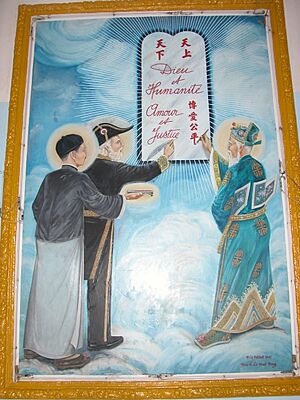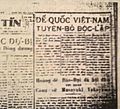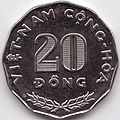Names of Vietnam facts for kids
Throughout history, many names have been used to refer to Vietnam.
Contents
History
Over time, Vietnam has been known by many different names. Some were official, while others were used informally. For example, during the Hùng Vương Dynasty, it was called Văn Lang. Later, under King An Dương, it was known as Âu Lạc.
The Triệu dynasty called it Nam Việt. The Anterior Lý Dynasty used Van Xuan. During the Đinh dynasty and Early Lê dynasty, it was called Đại Cồ Việt. From 1054, the country was known as Đại Việt, meaning "Great Viet." The Hồ dynasty briefly changed the name to Đại Ngu.
The name "Việt Nam" comes from "Nam Việt" (Southern Việt). This name dates back to the Triệu dynasty in the 2nd century BC. The word "Việt" is a shorter form of "Bách Việt." This term referred to people who lived in what is now southern China long ago.
The words "Việt Nam" in their current order first appeared in the 16th century. They were used in a poem by Nguyễn Bỉnh Khiêm. For a long time, especially during the colonial period, the country was often called "Annam." This was a Chinese name from the seventh century.
In the early 1900s, a writer named Phan Bội Châu helped bring back the name "Vietnam." When two different governments were formed in 1945, both quickly adopted "Vietnam" as the country's official name. In English, the two parts are usually combined into one word: "Vietnam." However, "Viet Nam" is still used by the United Nations and the Vietnamese government.
Origin of Vietnam
The word "Việt" (pronounced like "Yue") was first written down around 1200 BC. It was shown as a picture of an axe. At that time, it referred to a group of people or a leader. Later, in the 8th century BC, a tribe near the Yangtze River was called Yangyue. This term was then used for people further south.
Between the 7th and 4th centuries BC, "Yue" or "Việt" referred to the State of Yue and its people. This state was located in the lower Yangtze River area.
From the 3rd century BC, the term was used for non-Chinese groups. These groups lived in southern China and northern Vietnam. They included groups like Minyue, Ouyue, and Luoyue (also known as Lạc Việt). Together, they were called the Baiyue (Bách Việt), meaning "Hundred Yue/Viet." This term first appeared in a book around 239 BC.
In 207 BC, a general named Zhao Tuo (Triệu Đà) started the kingdom of Nanyue (Nam Việt). Its capital was in Panyu, which is now Guangzhou. This kingdom was called "southern" because it was south of other Baiyue kingdoms. Later Vietnamese rulers continued to use similar names.
The poet Nguyễn Bỉnh Khiêm (1491–1585) used the name "Vietnam" in its modern order. He wrote, "Vietnam is being created." At that time, the country was divided. By combining older names like Nam Việt and Đại Việt, he created a new name. This new name referred to a future united country. The word "nam" no longer just meant "Southern Viet." Instead, it meant Vietnam was "the South" compared to China, "the North."
This idea is also seen in a poem from 1077 by Lý Thường Kiệt. He wrote, "Over the mountains and rivers of the South, reigns the emperor of the South." The name "Việt Nam" has been found on old stone carvings from the 16th and 17th centuries. Emperor Gia Long officially used the name from 1804 to 1813. The Chinese emperor, Jiaqing, actually suggested the name "Việt Nam" after Gia Long asked to change his country's name.
The use of "Vietnam" became popular again in modern times. This was thanks to nationalists like Phan Bội Châu. His book, Việt Nam vong quốc sử (History of the Loss of Vietnam), came out in 1906. He also started the Việt Nam Quang Phục Hội (Vietnam Restoration League) in 1912.
However, most people still used "Annam." The name "Vietnam" was not widely known until 1930. This changed after the Yên Bái mutiny, organized by the Việt Nam Quốc Dân Đảng (Vietnamese Nationalist Party). By the early 1940s, "Việt Nam" was commonly used. It appeared in the name of Ho Chi Minh's Viet Nam Doc Lap Dong Minh Hoi (Viet Minh), founded in 1941. Even the French governor of Indochina used it in 1942. The name "Vietnam" has been official since 1945. Both the imperial government and Ho Chi Minh's government adopted it that year.
Other names
Here are some other names Vietnam has been called throughout history:
- Giao Chỉ (or Giao Chỉ xứ): This name was used during periods of Chinese domination. It refers to the region.
- Giao Châu: Another name used during Chinese rule.
- Vạn Xuân quốc: Used during the Anterior Lý dynasty.
- Annam phủ: A Chinese name meaning "Pacified South." It was common during Chinese rule.
- Tĩnh Hải quân: Used during a period of Chinese domination before Vietnam became independent.
- Đại Cồ-việt quốc: Used by the Đinh dynasty, Early Lê dynasty, and early Lý dynasty.
- Đại Việt quốc: Meaning "Great Viet," this was a very common name for many dynasties. These included the Lý dynasty, Trần dynasty, Lê dynasty, and Nguyễn dynasty.
- Đại Ngu quốc: Used by the Hồ dynasty.
- Việt Nam quốc: Used by the Nguyễn dynasty from 1804 to 1839.
- Đại Nam quốc: Meaning "Great South," this was used by the Nguyễn dynasty from 1839 to 1945.
Official Names Since 1945
- Đế quốc Việt Nam (Empire of Vietnam): Briefly used in 1945.
- Việt Nam Dân chủ Cộng hòa (Democratic Republic of Vietnam): Used from 1945 to 1976 in the North.
- Quốc gia Việt Nam (State of Vietnam): Used from 1948 to 1955.
- Việt Nam Cộng hòa (Republic of Vietnam): Used from 1955 to 1975 in the South.
- Cộng hòa Xã hội chủ nghĩa Việt Nam (Socialist Republic of Vietnam): The official name from 1976 until today.
Other Unofficial Names
- Việt Thường thị: A name for people living south of the Nanling Mountains.
- Hoàng Việt quốc: A diplomatic name meaning "Country Viet in the South."
- An Nam quốc or Giao Chỉ quốc: Names used by Vietnamese people and foreigners.
- Đại Nam đế quốc or Empire d'Annam: Diplomatic names used during the colonial period.
- Union indochinoise or Liên bang Đông Dương: Names for the French colonial union.
Culture
In English, "Vietnam," "Viet-Nam," and "Viet Nam" have all been used. Over time, the single-word "Vietnam" became the most common.
In Chinese, the modern name for Vietnam (越南) can mean "Beyond the South." Some people think this refers to Vietnam being south of China's borders. Another idea is that it shows the difference between those who stayed in China and those who lived in Vietnam.
Japanese and Korean languages also used to refer to Vietnam with names based on Chinese characters. But later, they switched to phonetic spellings. For example, in Japanese, "Annan" and "Etsunan" were mostly replaced by "Betonamu." Similarly, in Korean, "Wollam" was replaced by "Beteunam" (South Korea) or "Wennam" (North Korea).
Images for kids
-
A newspaper reports the "Empire of Vietnam declared independence" in 1945.
-
Stamps from the Empire of Vietnam.
-
A coin from the Republic of Vietnam in 1960.
-
Stamps from the Republic of Vietnam in 1961.
-
The Vietnamese Embassy in Prague in 2012.










